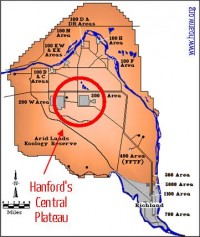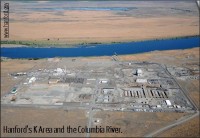Plutonium decision sets stage for inadequate cleanup
This summer, hundreds of Washington and Oregon residents strongly urged U.S. Department of Energy (DOE) to excavate as much plutonium as possible from highly contaminated areas of Hanford’s Central Plateau. In hearings from Portland to the Tri-Cities, kite-boarders, physicians, and conservationists pressured DOE to aggressively pursue cleanup of plutonium. According to DOE and the Environmental Protection Agency (EPA), the public’s message was clear and emphatic: plutonium is forever, and it should not be left in Hanford’s soils near the Columbia River.
Defying this overwhelming, unanimous sentiment, DOE decided to leave large quantities of uranium, plutonium, cesium, and other contaminants in Hanford soils. Most disturbingly, DOE argued that plutonium will remain “stable” in Hanford soils for the foreseeable future. Because of its long half-life, plutonium will remain dangerous for over 200,000 years in Hanford’s soils. Yet, DOE’s decision to curtail its cleanup of the Central Plateau assumes that – for those 200,000 years – plutonium will not move into groundwater and ultimately into the Columbia River. DOE reached this conclusion despite expert testimony that demonstrated the potential for plutonium to become mobile in Hanford’s soils.
Columbia Riverkeeper has called on DOE to withdraw this flawed decision, not only because it fails to protect the Columbia River, but also because it sets a dangerous precedent for future cleanup decisions. The Hanford Advisory Board, a broad regional board that operates on a consensus basis, has agreed that DOE’s plutonium decision is unacceptable, as well.
What's Next: Will agencies do better Hanford's river corridor?
Even as the public and the Hanford Advisory Board continue to debate a controversial decision on plutonium cleanup, the DOE and EPA are approaching a major decision for another area of the Hanford site. In the K Area, a swath of land on the shores of the Columbia River that once stored leaking spent nuclear fuel, Riverkeeper is calling on EPA and DOE to remove pollution rather than relying on future restrictions on how the area will be used. For example, if DOE and EPA acknowledge that residents along the Columbia River could use irrigation in the future, they will have to dig deeper and remove more pollution.
As the decision-making process for cleaning up the K Area and other lands near the Columbia River unfolds, we will continue to update our members on opportunities to comment and attend hearings. Your voice is critical to ensure that the federal government does not take shortcuts in the ongoing effort to protect the Columbia River from Hanford’s chemical and radioactive pollution.
Learn more about Riverkeeper's work to cleanup the Hanford Nuclear Site.




